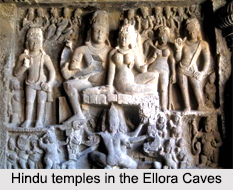 The Sculpture at Ellora Caves was done into the sides of a basaltic rock of the Charanadari hill in Deccan, at Aurangabad. These caves were built during the 5th-7th century. Some of these monastery caves have shrines that include carvings of Lord Buddha, bodhisattvas and saints. In many of these caves, sculptors have endeavoured to give the stone the look of wood.
The Sculpture at Ellora Caves was done into the sides of a basaltic rock of the Charanadari hill in Deccan, at Aurangabad. These caves were built during the 5th-7th century. Some of these monastery caves have shrines that include carvings of Lord Buddha, bodhisattvas and saints. In many of these caves, sculptors have endeavoured to give the stone the look of wood.
The Buddhist "Carpenter`s" cave or cave 10 or "Vishwakarma" has the apsidal end of a stupa on the face of which a colossal 3.30 m high seated Buddha in "vyakhyana mudra" is carved. A large Bodhi tree is also carved at the back.
History of Sculpture at Ellora Caves
The Hindu caves were constructed between the middle of 6th century to the end of the 8th century. Kailasanatha temple has wall carvings. For example there is a scene depicting the wedding of Shiva and Parvati. Shiva-Parvati is shown seated on mount Kailash, while Ravana tries to lift it.
Sculptural works at Ellora Caves
The Ellora Caves, listed from 1 to 12, were constructed during 630 - 700 AD. Latest are caves 11 and 12, oldest is cave 6. These are the major Buddhist cave temples in India.
 Buddhist Caves: In cave number 2, there is large "vihara" with vast central chamber supported by 12 square pillars and is decorated with several sculptures of seated Buddha. The cave 6 was created after 600 AD. There are two stunning sculptures of star goddess Tara and goddess Mahamayuri with peacock. Cave 10 is the most celebrated local Buddhist cave, "chaitya griha". There is 3.3 m high Buddha statue placed in speaking pose. Behind Buddha, on the back wall there is a large carved Bodhi tree. Initially, the cave had a big screen hall, now ruined. In cave 11, one of latest Buddhist structure "vihara" with the three storeys is present here. Upper hall contains five large sculptures of bodhisattvas; the hall is edged by seven Buddhas.
Buddhist Caves: In cave number 2, there is large "vihara" with vast central chamber supported by 12 square pillars and is decorated with several sculptures of seated Buddha. The cave 6 was created after 600 AD. There are two stunning sculptures of star goddess Tara and goddess Mahamayuri with peacock. Cave 10 is the most celebrated local Buddhist cave, "chaitya griha". There is 3.3 m high Buddha statue placed in speaking pose. Behind Buddha, on the back wall there is a large carved Bodhi tree. Initially, the cave had a big screen hall, now ruined. In cave 11, one of latest Buddhist structure "vihara" with the three storeys is present here. Upper hall contains five large sculptures of bodhisattvas; the hall is edged by seven Buddhas.
Hindu Caves: The cave 14 was constructed in the early 600s which contains beautiful stone carvings. It was initially shaped as a Buddhist "vihara" but during the work it was converted to Hindu shrine. The cave 15 was built in the middle of the 8th century and is also known as the Dashavatar cave as it depicts the ten avatars of Vishnu. The upper floor contains some of the most exquisite carvings. It was shaped like open court with free-standing colossal "mandapa" with two-storeyed cave temple at the rear. The cave contains exquisite sculptural groups depicting scenes of Hindu religious motifs including panels with five of Vishnu"s ten incarnations - avatars. The cave 16 was designed to resemble Mount Kailasha. Kaliash Temple is free standing structure with many stories. It is the largest monolithic human built structure of the world, up to 36.6 metres high. The giant mandapa is held by numerous life-sized elephants - also carved out of the original rock. The cave 21 is the oldest Hindu cave in Ellora, constructed during the late 500s with some of the most beautiful carvings. Two beautiful figurines of river goddesses Ganga and Yamuna are carved at the far end of entrance of verandah. The cave 25 contains beautiful sculpture of Surya the Sun god, driving his chariot towards the dawn. Cave 29 depicts the beautiful sculpted panels with depictions of Shiva and other exquisite carvings.
Jain Caves: After Hindu Caves, there comes the number of Jain Caves. Built between 800 AD and 1000 AD, five caves (Cave 30 to 34) belong to the Jains. Again the caves are adorned with images of the Lords and various mythological pictures. Cave 32 has some beautiful sculptural works. The ceiling is adorned with enormous carving of lotus and the sculpture of naked Gomateshwara who stands meditating in a forest without noticing how the vines have grown and twisted around his legs and scorpions and snakes crawl around him.



















